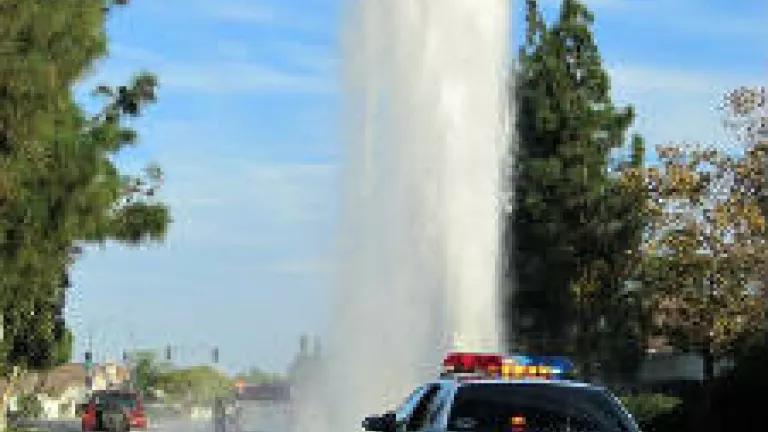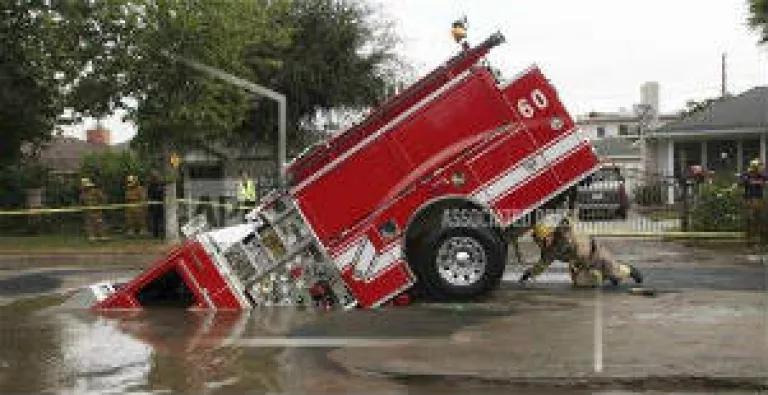
But only a small number of water main breaks actually make the news. And all the main breaks put together are only a fraction of the total amount of water being lost every day from water utility pipes. Much more water is lost from leaks that continue unseen for months and even years.
At right: Water Main Break, San Diego, 2009
Photo Credit Flickr: Jun
California is estimated to lose about 10% of its supply of treated drinking water due to leakage from water utility pipes. These losses are an unrelenting “tax” on the water system and its customers – robbing families and communities of clean water year after year. Even during an emergency, a Governor or Mayor can no more effectively order these losses to cease than King Canute of old could order the ocean’s tide to go out.
Things may be starting to change, however. Under a recommendation recently made by a State panel to the Legislature, California would become the Nation’s sixth state to require urban water suppliers to annually report the losses from their water distribution systems using a consistent methodology and format developed by the American Water Works Association, the trade association for drinking water professionals and utilities. Georgia, Rhode Island, Tennessee, Texas, and Wisconsin already have such requirements in place, and Maryland, New Mexico, and numerous other states have moved in somewhat similar ways to strengthen and standardize water loss reporting in recent years. In the grip of an acute drought, California is now scrambling to catch up.

Above: Sink hole created by a water main break, Los Angeles 2009
Photo Credit: Nick Ut/AP Photos
Many water suppliers in California already use the AWWA format voluntarily as an aid to monitoring the status of their infrastructure and for planning capital replacements and maintenance strategies. One of the key benchmarks of performance that is generated by the AWWA method is the volume of water lost from the system divided by the number of customers connected to the system -- expressed as “gallons of water lost per service connection per day.” This allows for a fair comparison of large and small utilities. NRDC recently took a look at the first 40 or so water utilities that completed their assessments for 2012, and found a wide range of performance, from a low of about 10 gallons per customer per day to a high of over 130 gallons per customer per day. The latter figure is larger than the total water use of some small, frugal households. Cities losing this much water before it ever reaches customers are in a poor position to advise customers to conserve.

Engineers are fond of saying “You can’t manage what you can’t measure,” and for decades water losses from buried water mains were accepted as an inevitable cost of doing business that was not worth worrying about if kept under 10%, 15%, or 20% -- different rules of thumb were used in different states. Now AWWA is telling its member utilities to forget about percentages, and instead calculate the volumes of water losses, the cost of loss reduction strategies, and the amount of water losses that might be cost-effectively prevented. For California, a first order estimate is that the loss of about 350,000 acre-feet of treated drinking water currently going to waste each year could be cost-effectively saved – a volume that is nearly double the entire annual water use of San Diego, the state's second largest city.
Left: Acoustic monitoring, a better way to find leaks
Photo: Vivax – Metrotech Corp
With California now facing acute water shortages after the driest year in its recorded history – and getting a glimpse of the “new normal” produced by a changing climate – the time to measure, manage, and eliminate the unnecessary waste of water right under our feet is now. As consumers, we have many ways to many ways to avoid wasting water around our homes, including the "Nine Ways to Save" listed here. But out in the street, it's the utilities' job to manage the pipes they own to reduce leakage and stop wasting this essential resource.

